One of the biggest products in demand globally is knitwear. Knitwear is a fundamental component of daily life and is created on a variety of knitting machines. After processing, the raw material can be transformed into the finished knitted item. The circular knitting machine, which is a sizable circular knitting machine, is the most commonly used form of knitting machine.
The single jersey knitting machine will be used as an example in this article to introduce the various parts of the circular knitting machine and their functions in the form of photos and text.
Yarn Creel: The yarn creel consists of 3 parts.
The first part is the creel, which is a vertical aluminum rod in which the creel is placed to hold the yarn cone. It is also known as side creel.
The second part is the cone holder, which is an inclined metal rod in which the yarn cone is placed to efficiently feed the yarn into the yarn feeder. It is also known as a cone carrier.
The third part is the Aluminum Telescopic Tube, this is the tube the yarn goes through. It reaches the yarn to the positive feeder. It is used as a yarn cover. It protects the yarn from excessive friction, dust, and flying fibers.
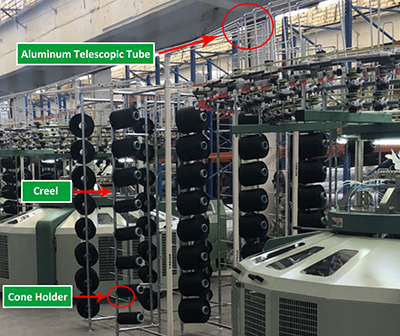
Figure: Yarn Creel
Positive feeder (takes Memminger MPF-L positive feeder as an example): the positive feeder receives the yarn from the aluminum telescoping tube. Since the device positively feeds the yarn into the needle, it is called a positive yarn feeder device. The positive feeder provides uniform tension to the yarn, reduces machine downtime, can identify and remove yarn knots, and issues a warning signal in the event of yarn breaks.
It is mainly divided into 7 parts.
1. Winding wheel and driven pulley: Some yarn rolls on the winding wheel so that if the yarn is torn, the whole yarn does not need to be replaced again. The driven pulley controls the speed of the positive feeder.
2. Yarn Tensioner: A yarn tensioner is a device that ensures the appropriate gripping of the yarn.
3. Stopper: The stopper is part of positive feeder. The yarn passes through the stopper and connects to the sensor. If the yarn breaks, the stopper moves up and the sensor receives a signal to stop the machine. At the same time, a ray of light also flashed. Generally, there are two types of stoppers. Top stopper and bottom stopper.
4. Sensor: The sensor is located in the positive feeder. If any of the stops move up due to a yarn break, the sensor automatically receives the signal and stops the machine.
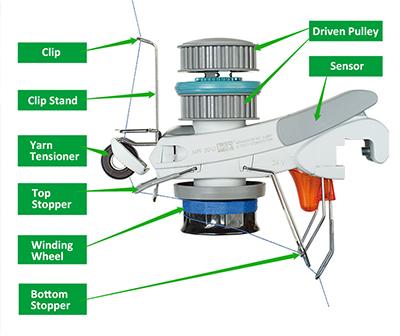
Figure: Memminger MPF-L positive feeder
Lycra feeder: Lycra yarn is feed by the lycra feeder.
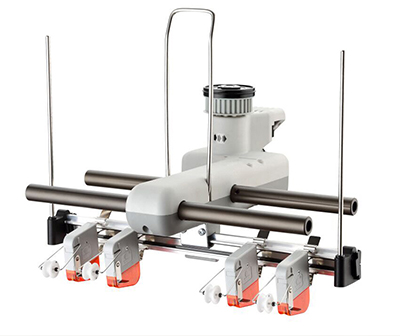
Figure: lycra feeder device
Yarn guide: The yarn guide receives the yarn from the positive feeder. It is used to guide the yarn and feed the yarn to the yarn guide. It maintains the smooth tension of the yarn.
Feeder guide: The feeder guide receives the yarn from the yarn guide and feeds the yarn to the needles. It is the last device that releases the yarn into the knitted fabric.
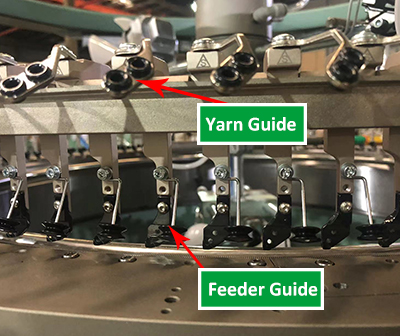
Figure: Yarn guide & feeder guide
Feeder Ring: This is a circular ring that holds all the feeder guides.
Base Plate: The base plate is the plate that holds the cylinder. It is located on the body.
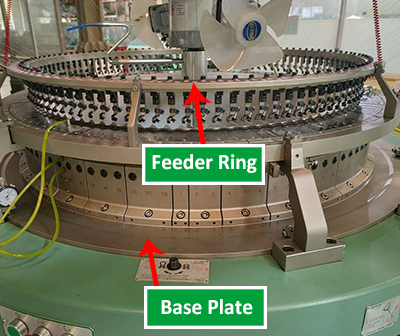
Figure: Feeder Ring & Base Plate
Needle: The needle is the main component of the knitting machine. The needles receive the yarn from the feeder, form the loops and release the old loops, and finally produce the fabric.
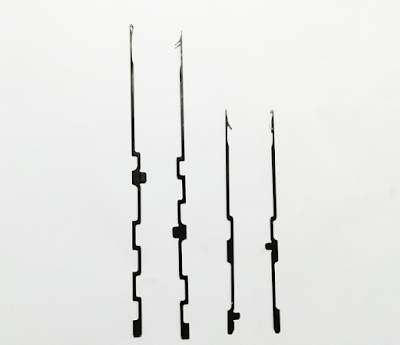
Figure: Knitting machine needle
VDQ Pulley: VDQ means Variable Dia for Quality. Because this kind of pulley controls the quality of knitted fabric by adjusting GSM and stitch length during the knitting process, it is called VDQ pulley. To increase fabric GSM, the pulley is moved in the positive direction, and to decrease fabric GSM, the pulley is moved in the reverse direction. This pulley is also known as a quality adjustment pulley (QAP) or quality adjustment disk (QAD).
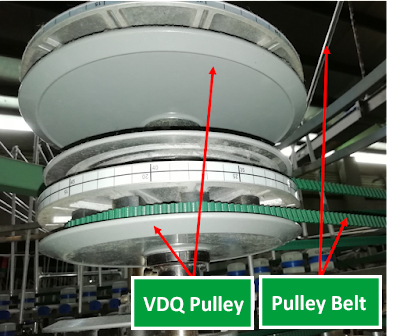
Figure: VDQ pulley and VDQ belt
Pulley Belt: A pulley belt provides motion to the pulleys
Cam: A cam is a device by which needles and some other devices convert rotary motion into a defined reciprocating motion.

Figure: Different kinds of CAM
Cam Box: The cam box holds and supports the cam. Knit, truck, and miss cam are arranged horizontally according to the fabric design in the cam box.
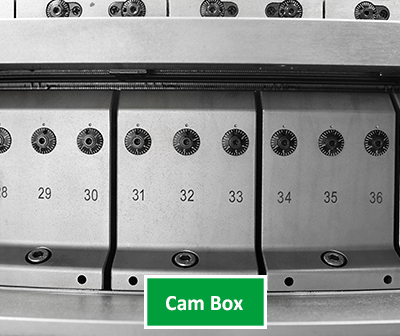
Figure: Cam Box
Sinker: The sinker is another major component of the knitting machine. It supports the loops required for yarn formation. A sinker is located in each gap of the needle.
Sinker Box: The sinker box holds and supports the sinker.
Sinker Ring: This is a circular ring that holds all the sinker box
Cylinder: The cylinder is another major component of a knitting machine. Cylinder adjustment is one of the most important technical works. The cylinder holds and carries needles, cam boxes, sinkers, etc.
Air Blow Gun: A device that is connected to high-velocity pressurized air. It blows the yarn through the aluminum tube. And it is also used for cleaning purposes.
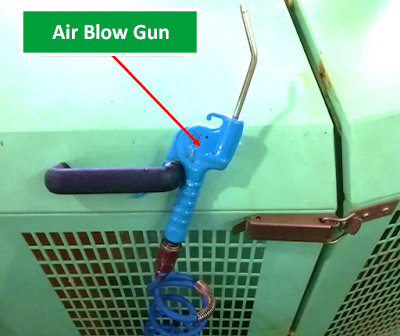
Figure: Air Blow Gun
Automatic Needle Detector: A device located very close to the needle set. It will signal if it finds any broken or damaged needles.
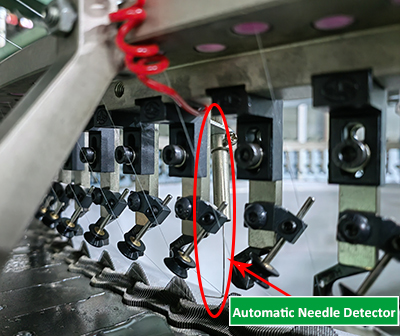
Figure: Automatic Needle Detector
Fabric detector: If the fabric is torn or dropped from the machine, the fabric detector will touch the cylinder and the machine will stop. It is also known as a fabric fault detector.
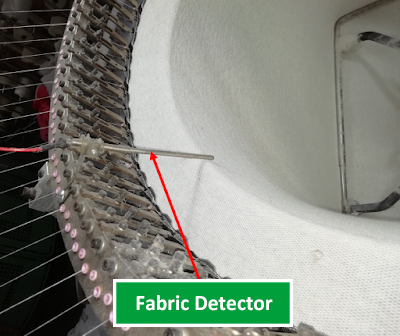
Figure: Fabric Detector
Adjustable Fans: Typically there are two sets of fans operating in continuous circulation from the center of the machine diameter. The needle tips of these fans remove dust and lint and keep the needles cool. The adjustable fan rotates in the opposite motion of the cylinder.
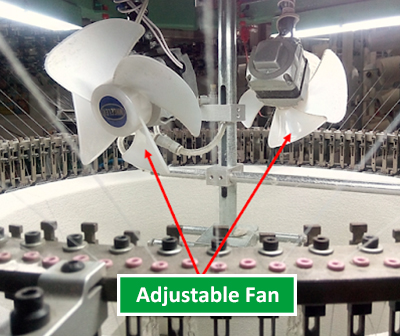
Figure: Adjustable Fans
Lubrication Tube: This tube provides lubricant to the cam box, and sincar box to remove excess friction and heat. The lubricant is delivered through the pipes with the help of an air compressor.
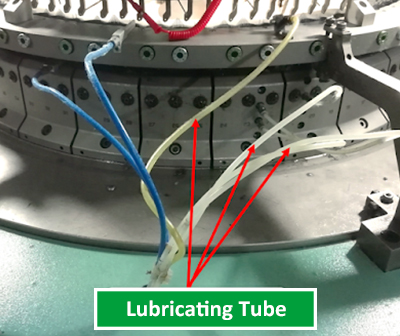
Figure: Lubrication tube
Body: The body of the knitting machine covers the entire area of the machine. It holds the base plate, cylinder, etc.
Manual Jig: It is attached to the machine body. Used for manual adjustment of knitting needles, sinkers, etc.
Gate: The gate is located under the machine bed. It keeps covered knits fabric, take-down motion rollers, and winding rollers.
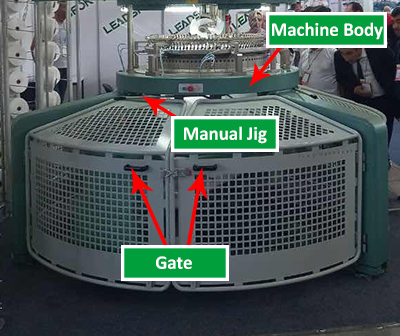
Figure: Machine Body & Manual Jig & Gate
Spreader: The spreader is located under the machine body. It receives the fabric from the needles, spreads the fabric, and ensures uniform fabric tension. Fabric is to open type or tube type adjustment.
Take-Down Motion Rollers: The take-down motion rollers are located under the spreader. They pull the fabric off the spreader, grab the fabric firmly and remove it. These rollers are also known as fabric withdraw rollers.
Winding Roller: This roller is located directly below the take-down motion roller. It rolls the fabric itself. As this roller becomes larger with layers of fabric, it also moves upwards.
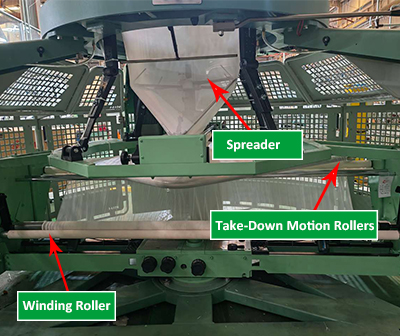
Figure: Spreader & Take-Down Motion Roller & Winding Roller
That's all for the article. If you are interested in our leadsfon knitting circular knitting machine, please contact us!
Post time: Jan-06-2023
